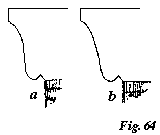374 THE STONES OF VENICE DECORATION
line at the top of the original cornice begins to slope outwards, and through a series of years rises like the hazel wand in the hand of a diviner:-but how slowly! a stone dial which marches but 45 degrees in three centuries, and through the intermediate condition 5 arrives at 6, and so stays.
In tracing this chain I have kept all the profiles of the same height in order to make the comparison more easy; the depth chosen is about intermediate between that which is customary in cornices on the one hand, which are often a little shorter, and capitals on the other, which are often a little deeper.* And it is to be noted that the profiles 5 and 6 establish themselves in capitals chiefly, while 4 is retained in cornices to the latest times.
§ 28. Second group (c, Fig. 63). If the lower angle, which was quickly felt to be hard, 
* The reader must always remember that a cornice, in becoming a capital, must, if not originally bold and deep, have depth added to its profile, in order to reach the just proportion of the lower member of the shaft head; and that therefore the small Greek egg cornices are utterly incapable of becoming capitals till they have totally changed their form and depth. The Renaissance architects, who never obtained hold of a right principle but they made it worse than a wrong one by misapplication, caught the idea of turning the cornice into a capital, but did not comprehend the necessity of the accompanying change of depth. Hence we have pilaster heads formed of small egg-cornices, and that meanest of all mean heads of shafts, the coarse Roman Doric profile, chopped into a small egg and arrow moulding, both which may be seen disfiguring half the buildings in London.
[Version 0.04: March 2008]